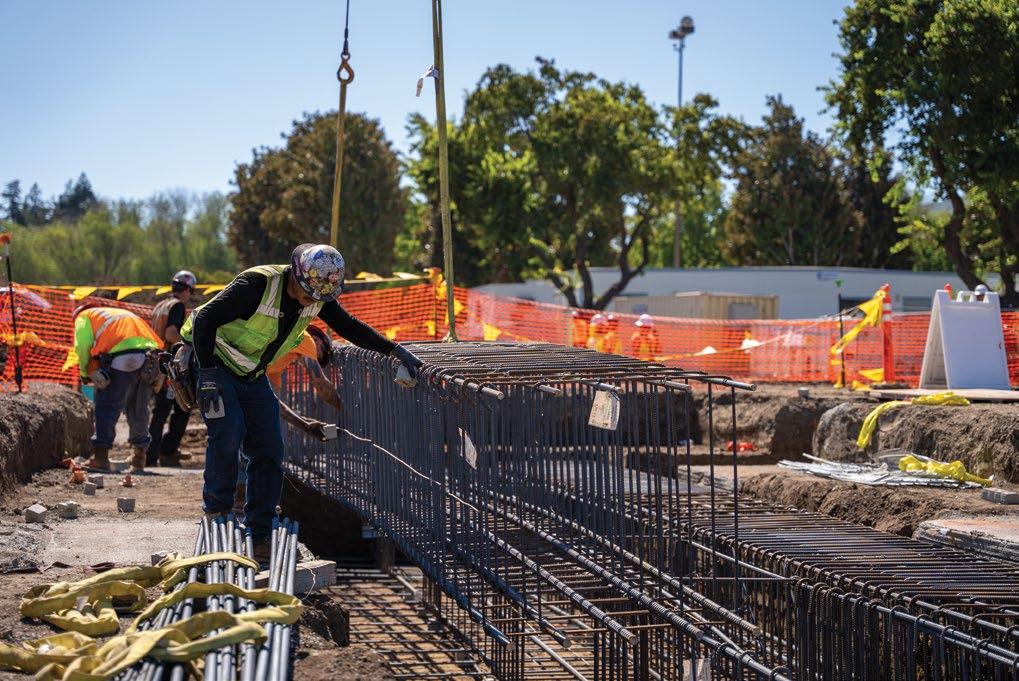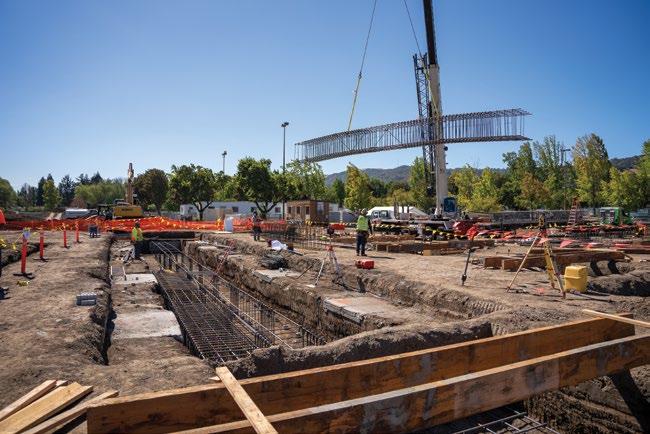
8 minute read
Benefits of adopting Virtual Design and Construction
Projects can be successfully delivered using cloud-based solutions.
The construction industry has faced disruptions during the COVID-19 lockdowns and continues to face a shortage of labour. To help overcome this, DPR Construction, a general contractor and construction manager is leveraging Virtual Design and Construction (VDC) methods to navigate workflow constraints resulting from disruptions. VDC, by nature, is extremely compatible with a remote working environment. DPR’s teams are virtually building projects using cloudbased solutions like BIM Track and Autodesk BIM 360, in conjunction with web platforms like StructionSite to seamlessly collaborate, share ideas and create content to navigate constraints posed by the disruptions. VDC services like design coordination are enabled by a data-rich Building Information Model (BIM) and applied design integration processes, which DPR uses to identify and resolve issues before construction begins. In early design phases, better collaboration and information enables project teams to make more informed decisions about design intent and constructability. When issues are addressed at this stage of the project, it leads to better predictability, productivity and quality. Many assume that design coordination happens by default on projects set up for a high level of collaboration using Integrated Project Delivery or design-build. While it happens more often on these types of projects, silos can still exist in execution. Additionally, throughout the industry, budgets for design integration and preconstruction services are traditionally on the lighter side. At the same time, the construction budgets can be inflated with contingency budgets, mainly due to unforeseen issues that can actually be resolved during the preconstruction phase, without the added cost impact, delays or rework during operations. Through applications of VDC and clash detection, DPR has identified over thousands of issues, ranging from existing conditions, to design specifications, to maintenance access, to constructability and to traditional trade coordination issues. Using the BIM Track platform, DPR can analyse issues by location, system priority, impact and other sets of criteria, to calculate the priority in which design issues should be addressed and resolved. Assigning and tracking issue accountability for all project team members translates to more agile issue resolution. It also helps to promote ‘right behaviours’ through the ability to track progress and overall project team performance using data points, such as average time to resolve issues and issue accountability. With this information, along with historical data about the company’s core markets, DPR can inform owners and designers of typical design challenges and equip them with the added knowledge to make better and more informed decisions.
VDC applications
On a recent life sciences project in the US, DPR converted an existing 261,000 ft2 office into a multipurpose facility including labs, clean rooms and clinical spaces, over the span of 15 months. The project stipulated liquidated damages which made coordination even more critical to ensuring successful delivery. During the coordination process, more than 2,000 issues were identified and resolved by the project team, resulting in only 150 RFIs (Requests For Information) and no impacts to schedule. After completing the coordination, DPR reviewed six major roadblocks and assessed the averted impact to the project. The results were dramatic. If not for VDC coordination and early trade engagement, the project would have hit a 14-week delay. When comparing associated costs for the six roadblocks to the cost for coordination services, DPR found a 200% ROI. The benefits of model-based coordination have been fully embraced by the team as a best practice, moving forward. DPR finds that while more preconstruction budget is needed to properly apply VDC services in the preconstruction phase, rework during physical construction is significantly reduced and project teams can easily recoup the upfront investment. In most cases, the project realises ROIs that generate more than tangible cost savings, as well as qualitative value due to timely coordination efforts. Likewise, in an ongoing design-tobuild project in Singapore, the DPR team is seeing the advantages of using VDC: • The project’s design was completed in VDC, prior to creation of drawings. By doing so, DPR could share information with trade partners more quickly – weeks earlier, as compared to the traditional way of preparing 2D drawings. • During the tender stage, VDC aided the procurement team in determining the accuracy of trade partner quantity take-offs and assumptions. Normally, it is a challenge to quantify mechanical, electrical and plumbing (MEP) services based on 2D drawings, since these do not show routing and vertical movement of services across floors. If DPR saw major variances, these were highlighted to the trade partner, resulting in lower tender returns.
The installation of rebar cages. Projects can be delivered faster and safer, through the application of prefabrication and VDC, and the utilisation of design resources and strategic partnerships.
• The project had a low floor-tofloor height, with more than nine layers of services that had to be routed within a technical floor.
Without VDC, DPR would have needed to factor in tolerance for site installation and not have been able to easily coordinate within the tight ceiling space. • On a weekly basis, the DPR team uses a LiDAR (Light Detection and Ranging) scanner to capture any services that may not have been installed in the right location. Any deviations are quickly rectified, if needed. If not, the design is quickly amended in the
BIM model to notify subsequent installations. This process alone saved the project hundreds of thousands of dollars in possible late rework. “There is an objective and quantifiable return on investment by using VDC. By making slight adjustments to how the project teams, including owners, designers, contractor and trade partners integrate early, it is possible to influence and mitigate the impact of design changes, later down the road, during construction”, said Mr Richard Kimber, Managing Director for Singapore and Southeast Asia, DPR Construction.
DPR Construction
US-headquartered DPR Construction is a general contractor and construction manager, specialising in technically complex and sustainable projects for the advanced technology, life sciences, healthcare, higher education and commercial markets. Its portfolio of work ranges from large-scale new construction to small tenant improvements and special projects. It has leveraged the use of technologies to deliver more predictable outcomes through application of VDC and prefabrication. DPR’s Asia Pacific operations bring global, technical and construction expertise to the region. In Singapore, DPR Asia Pacific is a BCAregistered contractor.

Applying elements of a design-to-build approach to project delivery.
Ensuring successful outcomes
‘The Singapore Engineer’ finds out more on the application of VDC, from Mr Richard Kimber, Managing Director for Singapore and Southeast Asia, DPR Construction.

Mr Richard Kimber
The Singapore Engineer (TSE): Could you briefly define Virtual Design and Construction (VDC)?
Richard Kimber (RK): Virtual Design & Construction (VDC) is a process focused on using Building Information Models (BIM) to improve the design coordination and building process, through a visual medium. It integrates project information and presents the information in 3D. However, VDC is more than just having a 3D model, it is about combining people, process and tools, to better execute projects.
TSE: What are some of the main advantages gained through the adoption of VDC?
RK: We have an opportunity to ensure quality, schedule and safety, by identifying and removing unknown constraints that typically result in rework, system underperformance, cost overruns and/or schedule delays. When VDC is executed well, we can improve building performance through optimising design and ensuring field installation quality, and also achieve more predictable cost and schedule outcomes for our clients, because we have a digital twin (prototype) that allows us to solve problems before construction.
TSE: In the context of Singapore, what are the main challenges that are hindering the more widespread adoption of VDC?
Firstly, customers are not as familiar with the advantages of VDC and thus are not willing to pay for VDC. Secondly, there are non-collaborative procurement methods being followed. Thirdly, many see VDC as BIM 4D and 5D or a 3D model with additional information on schedule and cost, and not as a framework that provides clear guidelines for the management of multi-disciplinary models in building projects.
TSE: Could you give us an example of a project in Singapore, where the adoption of VDC has produced significant gains?
RK: We have been involved in a biotech manufacturing facility project which is expected to be completed in December 2022. The facility includes a 280,000 ft2, steel framed, three-storey main building. The integrated design delivery (IDD) process ensured that the complex, multi-trade coordination was done, well in advance, and supported critical fabrication and installation milestones. The field installation was therefore productive and efficient. All trade models were completed to Level of Design (LOD) 400 and our onsite VDC team ensured that the field installation was completed as per the coordinated model, by using LiDAR and model comparisons. This has resulted in minimal field discrepancies, thus ensuring that we can achieve our key project schedule milestones.
TSE: Were there interoperability issues among the different software systems used by the different stakeholders?
RK: The team at our biotech manufacturing facility found success in a cloud-hosted solution, BIM 360 Design Collaboration, which supports model hosting, real-time collaboration and agile issue resolution. The interoperability issues of the past are less common now, since platforms like Autodesk Navisworks supports multiple file formats and we can convert files into IFC standard or Revit for easier file federation in BIM 360.
TSE: How would you summarise the application and value of VDC?
RK: Virtual Design & Construction is a ‘team sport’. In order to realise the true benefits of VDC, a culture of collaboration and increased trust is needed, from everyone on the project, and support is needed from the client. The timely onboarding of key subcontractors is critical, so that project stakeholders can provide timely input. This means that we need to onboard certain design-assist partners much earlier in the design process, and establish clear roles and responsibilities, define a design packaging and BIM execution plan, and a VDC execution framework that explains how everyone can contribute to the team. It may sound like more work, but it actually saves work in the field and delivers measurably more value for all project stakeholders.





